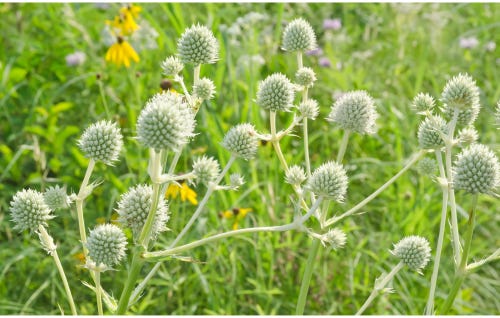Heat waves are miserable, but they have an upside: Just like us, plants need more water in the heat. So if you’ve been thinking about replacing some (or all) of your lawn, put the heat to work to help make that happen. I’ve written before about how much water we use on our lawns. Replacing thirsty cool-season grasses with something better suited to your location can make a huge difference.
Stop watering to find good areas for planted beds
One way to get things started is to stop watering or reduce the frequency pretty significantly. If you want to increase planted areas but aren’t sure where to put them, this can be helpful. Let the dying grass show you where to switch to something else. This will be in areas that get full sun. Shade—even part shade—will keep moisture in and allow the grass to survive longer. Those areas will also need less watering than full-sun spaces, which makes maintaining the remaining lawn more efficient. You can then start prepping those drier areas for fall planting.
Kill the lawn
Once you’ve decided where to replace the lawn, you’ll need to do more than just stop watering. Sure, a lot of that grass will die, but turf grass is hardier than it looks, and you don’t want it coming up between your new plants. We found that smothering with cardboard is highly effective. Be sure to use brown corrugated cardboard—nothing white or with shiny, printed sides—and remove any plastic tape or labels, which won’t break down.1 In a pinch, you can weight the cardboard down with bricks, stones, or other heavy items, but covering with mulch is more effective and helps cover any gaps.2 Both cardboard and mulch will break down into soil over time.

If you need to get the job done quickly, you can scrape off the grass (roots and all) and add a layer of garden soil on top. I don’t recommend using herbicides if you can help it, but if you must, try Sunday’s Weed Warrior. I used it to help with some persistent weeds when we were transitioning from fescue to buffalograss.3 It’s rated for organic gardening, so it’s safer than most other options. Note that it’s a broad-spectrum spray, so don’t get it on any plants you want to keep.
Start planning your new plantings
This is the fun part! Start researching perennial plants that are native to your area.
Be sure the plants you have in mind will do well in the location by checking how much sun and water they need. Make sure you’re choosing plants that flower at different times, so pollinators will have food available all season long and include plants of different sizes and flower types. Coneflowers are pretty, but mix in some liatris, bee balm, and other unusual flower shapes. (Rattlesnake master is my personal favorite and the pollinators LOVE it.) Try some amsonia for early blooms, a nice green backdrop in summer, and an assortment of colors in the fall. Asters and goldenrod make for great fall color.4

This is a good time of year to go see what’s available in nurseries, but don’t buy anything yet. Your soon-to-be planted beds need to sit a few months and the plants will do best if you put them in when it’s cool out. (And you can probably get them at a good discount in October.) Happy planning!
If you like One Simple Thing, please forward to a friend who might be interested in taking steps toward a healthier planet.
Where to get cardboard: if you have a local recycling drop-off center, stake it out for a while. We scored some big mattress boxes that way, and they smothered big sections without having to overlap edges. I also drove around our neighborhood on recycling day and took large boxes people had put out before they could be picked up.
It also looks nicer, which your neighbors will appreciate.
It’s great for sidewalk weeds.
I live in the Midwest, so these are good suggestions for Midwestern states. To find out what’s native near you, check out Lady Bird Johnson Wildflower Center’s plant database.




